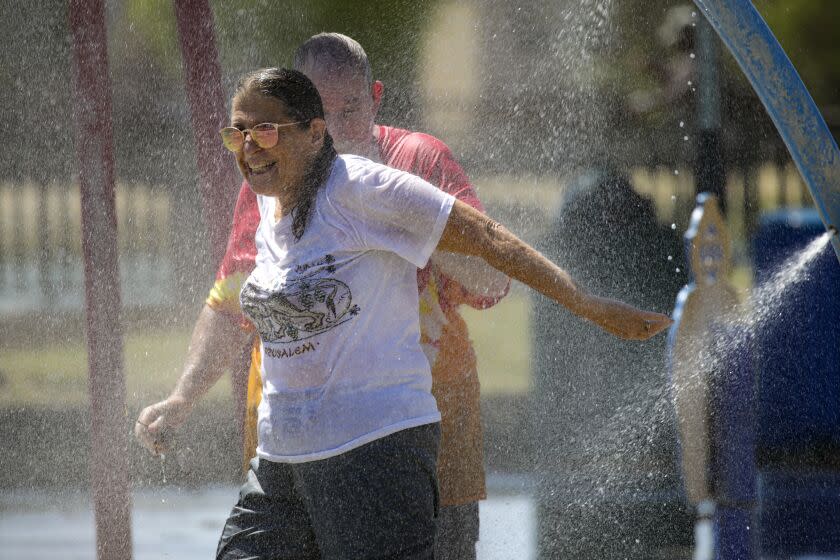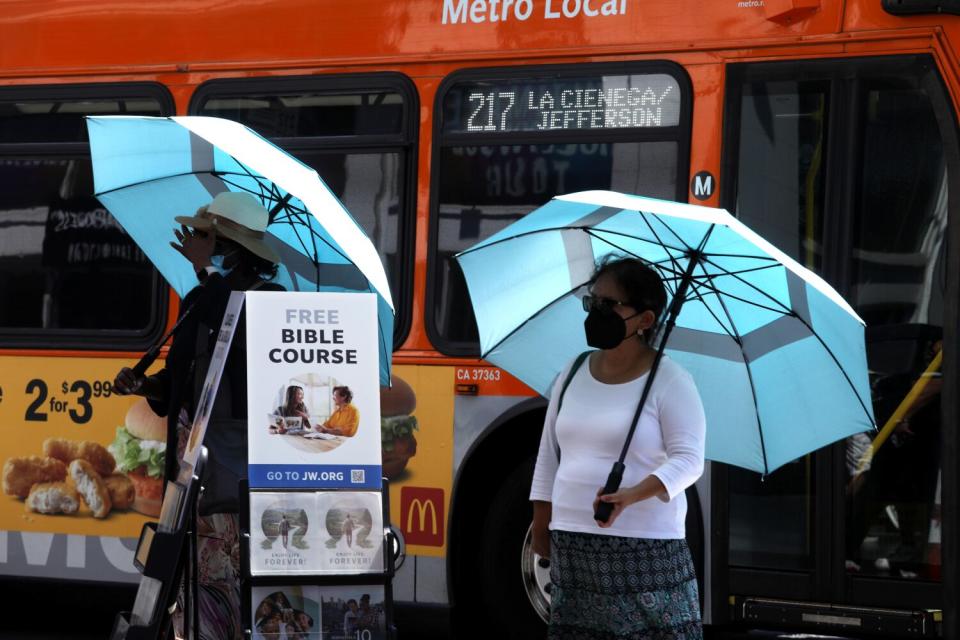Brutal SoCal heat wave extended to Thursday. What you need to know

Southern California's brutal heat wave is expected to continue until Thursday, bringing increased danger of fires, power outages and heat illness.
Sunday got off to a scorching start with many areas seeing triple-digit temperatures in the morning — even along the coast — with conditions expected to worsen in the afternoon. So far, Oxnard and Camarillo have already set daily records, and officials say the afternoon temperatures will likely be higher.
The forecast
The hottest temperatures are still ahead, National Weather Service emergency response specialist Sarah Rogowski said.
Rogowski said record or near-record temperatures were expected early to midweek, in the 80s and 90s along the coast and 100 to 115 in the Central Valley and inland regions of Southern California.
“We are looking at temperatures 10 to 25 degrees above normal for this time of year,” Rogowski said. Those will be compounded by unusually high overnight temperatures up to the 90s in some areas.
“We’re not getting that overnight relief,” she said.
Relief will come starting Thursday in the north and then Thursday afternoon and early Friday in Southern California, Rogowski said. Even then, temperatures will remain above normal.
Record heat
Southern California communities have set daily temperature records for the last four days.
On Saturday, San Diego, Chula Vista, Idyllwild and Lancaster hit new daily records.

Energy consumption
California power officials called for another Flex Alert on Sunday, the fifth in a row.
During a Flex Alert, consumers are asked to conserve energy from 4 to 9 p.m., hours when the grid is most stressed. Officials have warned rolling blackouts are possible during the heat wave due to excessive demand.
Californians are strongly urged to lower electricity use by setting thermostats to 78 or higher, health permitting, avoiding use of major appliances, and turning off all unnecessary lights, officials said.
Southern California Edison was experiencing an unusual number of heat-related power outages but has been able to restore power quickly, spokesman Ben Gallagher said. Because of the heat, crews were put on standby, equipment was stockpiled and regular maintenance was postponed, he said.
“We’re continuing to encourage our customers to conserve,” he said.
Heat tips
Stay informed
You can monitor your area’s forecast by going to the National Weather Service’s website and searching by city, state or ZIP Code for the latest weather updates and alerts. Follow local officials and agencies on social media for tips and information on available resources in your area. Keep an extreme heat checklist to make sure you are prepared.
Stay indoors and dress in light clothing
Officials from the National Weather Service and public health offices advise people to stay indoors as much as possible, particularly between 10 a.m. and 3 p.m. when the sun is strongest. If you exercise outdoors, it’s recommended to do so early in the morning or later in the evening.
If you don’t have air conditioning, the Centers for Disease Control and Prevention recommends going to a mall or public library. You can also refer to your county’s website or call the local health department to learn about cooling centers in your area. Other options include taking a cool shower twice a day or even finding a shaded yard or park. (Health officials at UCLA say electric fans will not prevent heat-related illnesses when temperatures reach the high 90s and above.)
RELATED: How to keep cool during Southern California’s heat wave
Watch out for heat-related illnesses
According to the CDC, heat-related illnesses can range from heat rashes and sun burns to more serious conditions including heat exhaustion and heatstroke, and result from the body’s inability to cool down by sweating. Signs of heatstroke, the most serious of the heat-related illnesses, include a temperature of 103 degrees or higher; hot, red, dry, or damp skin; fast, strong pulse; headache; dizziness; nausea; confusion and losing consciousness. If you’re experiencing these symptoms, seek immediate medical attention. The CDC advises against drinking anything and recommends moving to a cool place and into a cold bath or using a cold cloth.
Signs of heat exhaustion include heavy sweating; cold, pale and clammy skin; a fast, weak pulse; nausea or vomiting; muscle cramps; fatigue; dizziness; headaches; and fainting. If you’re showing these symptoms, get out of the sun immediately, seek a cool place or cool towels and sip water. Monitor your symptoms and get help if you are vomiting, if the symptoms worsen, or if they last longer than an hour.
Stay hydrated
Drinking plenty of fluids, particularly before going outdoors, is critical in preventing heat-related illnesses. Officials at UCLA warn against waiting until you’re thirsty to drink. During times of extreme heat, it’s best to drink at least two to four cups of water per hour. (For those working outside, the CDC suggests one cup of water, or 8 ounces, every 15–20 minutes.) Health officials also advise against drinking alcohol during times of extreme heat, as it causes dehydration and increases the risk of heat-related illnesses.
It’s also important to replenish the salt and minerals your body loses when it sweats by drinking low-sugar fruit juices or sports drinks. Dietitians also recommend eating foods with high water content — think watermelon, celery and cucumbers — along with drinking the right fluids.
Signs of dehydration in adults include extreme thirst; fatigue; dizziness; lightheadedness; dry mouth and/or lips, and infrequent urination. In infants or young children, look for dry mouths and tongues; no tears when crying; no wet diaper for more than three hours; sunken eyes and cheeks; a sunken soft spot on top of their head, and irritability or listlessness.
(If your doctor has you on a particular diet, or regulates how much water you drink, ask about what steps you should take during heat waves to stay properly hydrated.)
RELATED: How to keep your pets cool in this scorching heat
Check on the most vulnerable
In addition to keeping yourself safe and healthy, check in frequently with those who are at high risk, including seniors, children, pregnant women, the unhoused, those who work outside and those without air conditioning. Heat also affects your pets, so keep them indoors or if they will be outside, make sure they have plenty of water and a shaded area. Never leave a child or pet in the back seat of a car, as temperatures inside a vehicle can quickly skyrocket, even with windows cracked.
To help homeless people, the Los Angeles County Department of Public Health suggests donating water, electrolyte packages, light and loose-fitting clothing, tents, towels and other supplies to local organizations.
This story originally appeared in Los Angeles Times.

